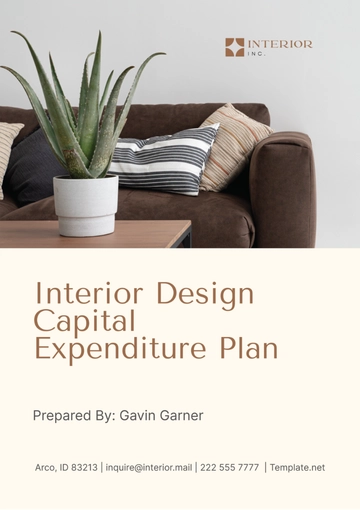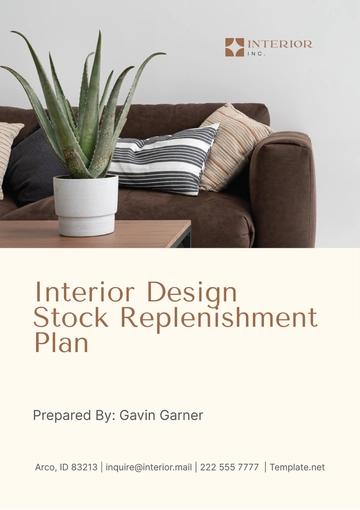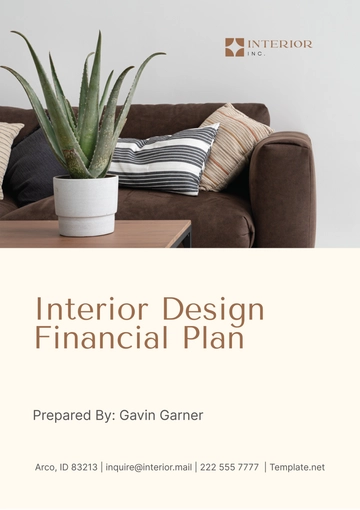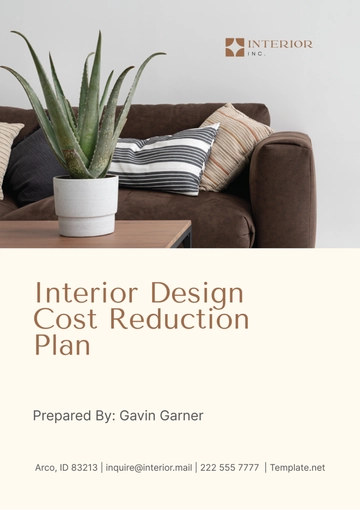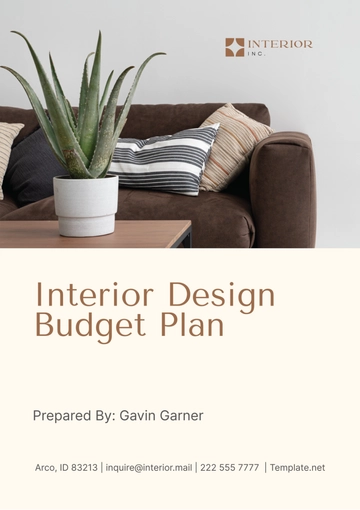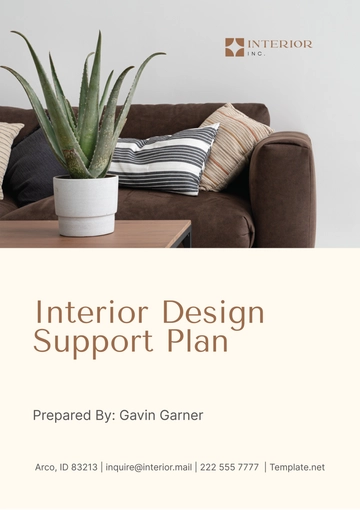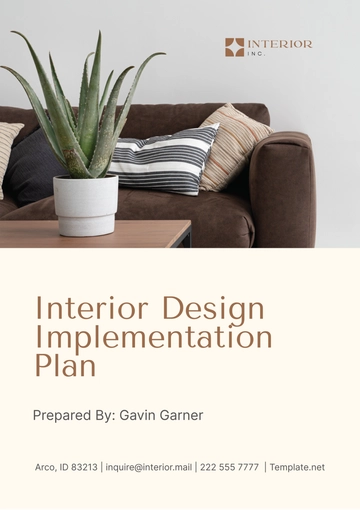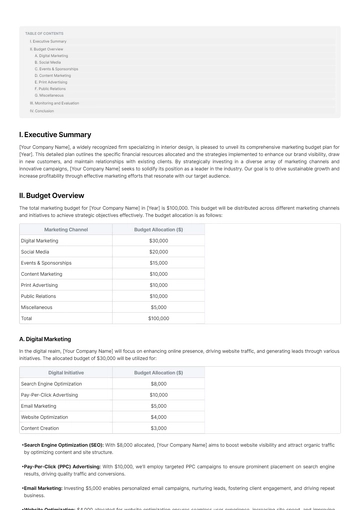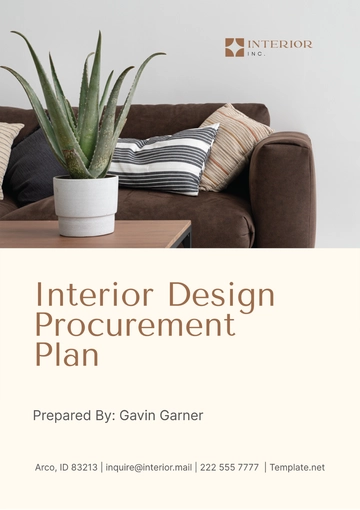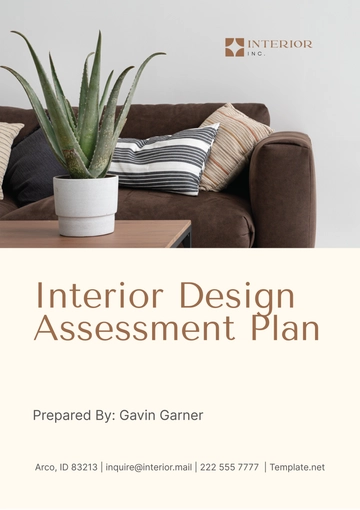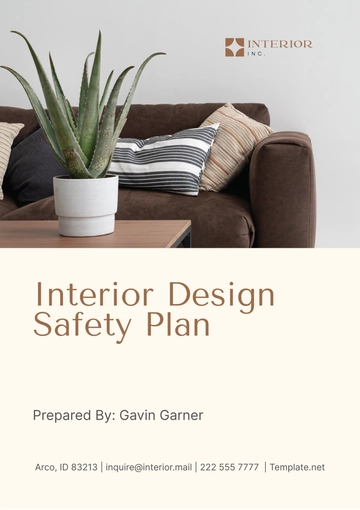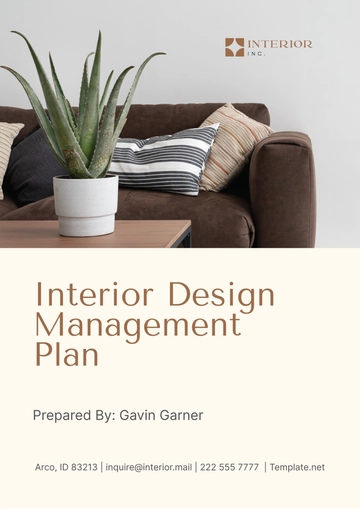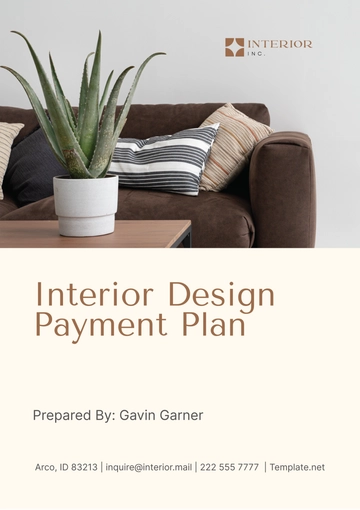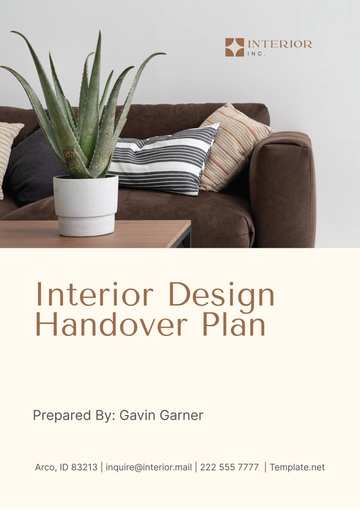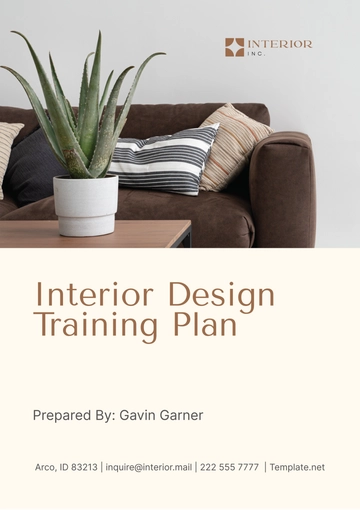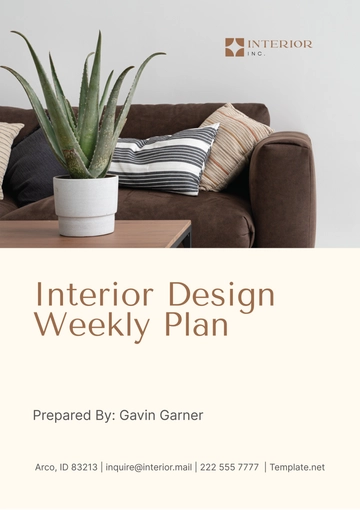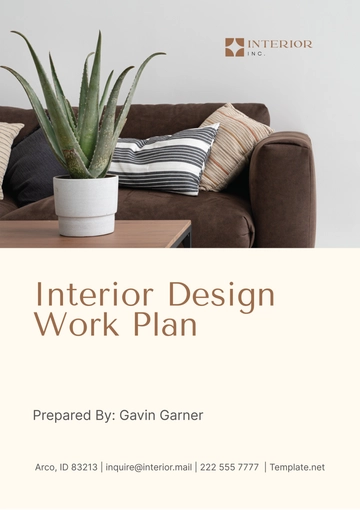Free Interior Design Procurement Plan
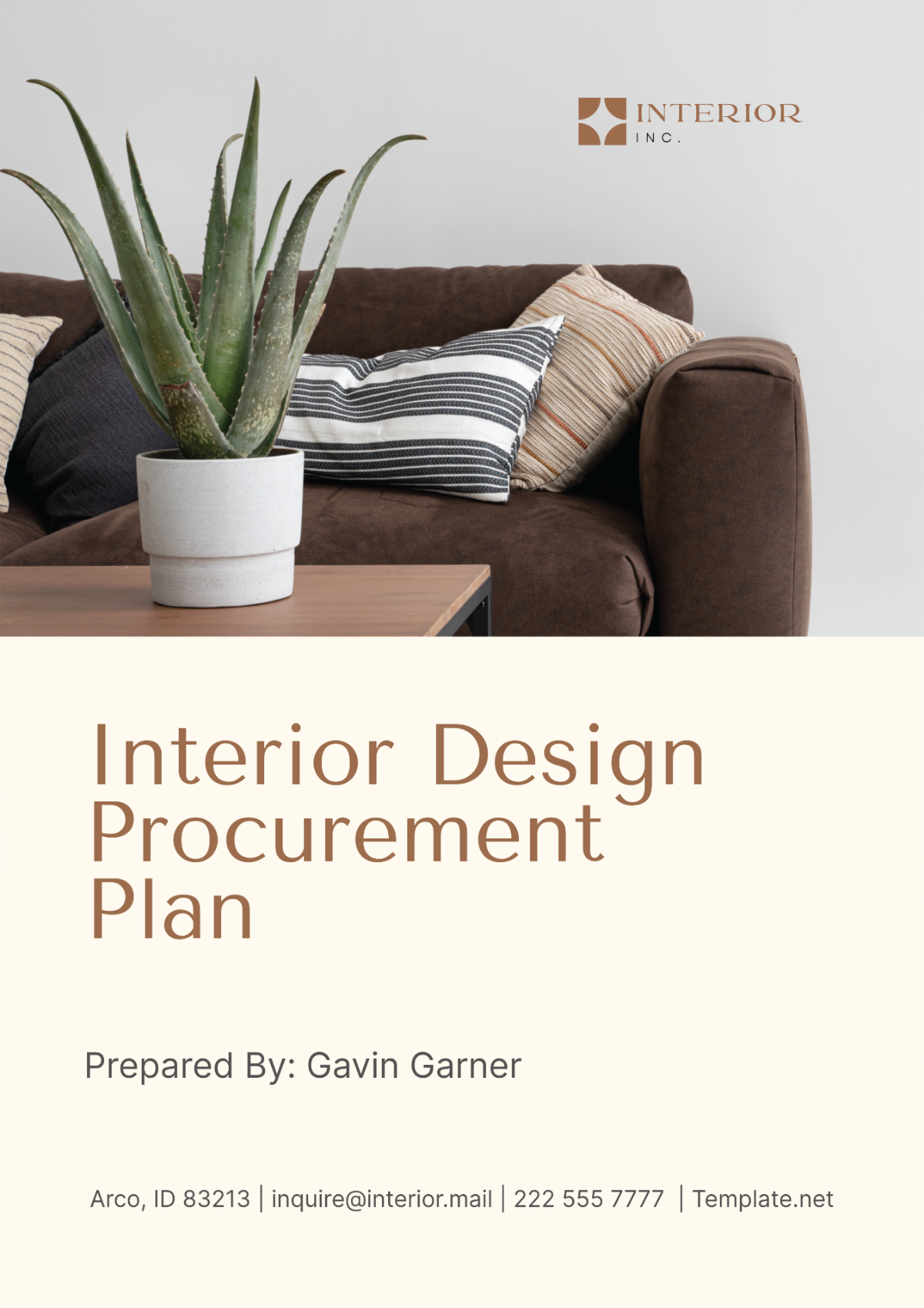
A. Introduction
Welcome to the Interior Design Procurement Plan, a comprehensive guide outlining the procedures and strategies for acquiring interior design services and products for [Your Company Name]. This document is designed to facilitate the smooth and efficient procurement of interior design elements necessary for enhancing our spaces and achieving our aesthetic and functional goals.
The primary objective of this procurement plan is to ensure that the interior design procurement process adheres to legal requirements, industry standards, and best practices while meeting the specific needs and preferences of our clients. By following this plan, we aim to streamline the procurement process, minimize risks, optimize cost-effectiveness, and ultimately deliver high-quality interior design solutions that exceed client expectations. This document serves as a reference for all stakeholders involved in the procurement process, including project managers, designers, vendors, and legal advisors, providing clear guidelines and procedures to ensure successful project outcomes.
B. Scope of Work
The scope of work for the interior design project encompasses a comprehensive range of activities aimed at conceptualizing, planning, designing, and implementing interior spaces that meet the functional and aesthetic requirements of our clients. This includes but is not limited to space planning, furniture selection, material specification, lighting design, color coordination, and procurement of furnishings and accessories.
Additionally, the scope defines the roles and responsibilities of the design team, contractors, vendors, and other stakeholders involved in the project. It establishes clear expectations regarding project timelines, milestones, and deliverables to ensure effective communication, collaboration, and accountability throughout the duration of the project. By delineating the scope of work upfront, we aim to minimize misunderstandings, mitigate risks, and ensure the successful execution of the interior design project within budget and schedule constraints.
C. Procurement Methodology
The procurement methodology outlines the approach and procedures for acquiring goods and services required for the interior design project. It encompasses the methods for sourcing, evaluating suppliers, and negotiating contracts to ensure the timely and cost-effective fulfillment of project requirements.
Sourcing Strategy
This involves identifying potential suppliers through market research, industry referrals, and requests for proposals (RFPs). We prioritize suppliers with proven expertise, quality products, competitive pricing, and a commitment to sustainability and ethical practices.
Supplier Evaluation
Supplier evaluation is conducted based on predefined criteria, including reputation, experience, financial stability, capacity, and compliance with legal and regulatory standards. We utilize a systematic approach to assess and compare suppliers to select those best suited to meet our project needs.
Contract Negotiation
Contract negotiation involves establishing mutually beneficial terms and conditions with selected suppliers. This includes defining project deliverables, pricing, payment terms, warranties, and dispute resolution mechanisms. We strive to negotiate fair and transparent contracts that protect our interests while fostering positive relationships with suppliers.
Procurement Execution
This entails issuing purchase orders, monitoring supplier performance, and managing logistics to ensure timely delivery of goods and services. We maintain open communication channels with suppliers and implement quality control measures to uphold project standards and mitigate risks.
Compliance and Ethics
Our procurement methodology adheres to all applicable laws, regulations, and industry standards, including those related to fair competition, labor practices, environmental protection, and diversity and inclusion. We promote ethical conduct and integrity throughout the procurement process, fostering trust and accountability among all stakeholders.
D. Supplier Selection Criteria
Selecting the right suppliers is crucial to the success of the interior design project. The following criteria are used to evaluate and choose suppliers who can meet our project requirements and standards:
1. Experience and Expertise
Demonstrated experience in providing interior design products and services.
Proven track record of successfully completing similar projects.
Expertise in specific areas such as space planning, furniture design, or sustainable materials.
2. Quality and Innovation
Commitment to delivering high-quality products and innovative design solutions.
Use of premium materials, craftsmanship, and production techniques.
Ability to customize products to meet unique project specifications.
3. Cost and Value
Competitive pricing that aligns with project budget constraints.
Transparent pricing structure with no hidden costs or unexpected fees.
Value-added services such as warranties, maintenance support, or volume discounts.
4. Reliability and Timeliness
Consistent delivery of products and services within agreed-upon timelines.
Proactive communication and responsiveness to project updates and inquiries.
Ability to adapt to changing project requirements and unforeseen challenges.
5. Sustainability and Ethics
Commitment to sustainable practices, including use of eco-friendly materials and manufacturing processes.
Compliance with ethical standards and labor practices, including fair wages and safe working conditions.
Certification or accreditation from recognized sustainability organizations or industry associations.
6. Financial Stability
Financial stability and solvency to fulfill contractual obligations and support long-term partnerships.
Positive credit history and references from financial institutions or trade partners.
Adequate insurance coverage to mitigate risks associated with product defects or project delays.
7. Reputation and References
Positive reputation within the industry and among previous clients.
Favorable references and testimonials from satisfied customers or industry peers.
Recognition or awards for excellence in design, craftsmanship, or customer service.
E. Procurement Schedule
Efficient procurement scheduling is essential to ensure the timely acquisition of materials and services needed for the interior design project. The following table outlines the key procurement activities and their corresponding timelines:
Procurement Activity | Start Date | End Date |
|---|---|---|
Market Research | [Month, Day, Year] | [Month, Day, Year] |
Supplier Identification | [Month, Day, Year] | [Month, Day, Year] |
Request for Proposals (RFP) | [Month, Day, Year] | [Month, Day, Year] |
Supplier Evaluation | [Month, Day, Year] | [Month, Day, Year] |
Contract Negotiation | [Month, Day, Year] | [Month, Day, Year] |
Purchase Order Issuance | [Month, Day, Year] | [Month, Day, Year] |
Product Delivery | [Month, Day, Year] | [Month, Day, Year] |
This schedule serves as a guideline for coordinating procurement activities and ensures that materials and services are acquired in a timely manner to support the overall project timeline. Adjustments may be made as necessary to accommodate changes in project scope or unforeseen delays.
F. Contract Terms and Conditions
The Contract Terms and Conditions serve as the legal framework governing the relationship between [Your Company Name] and its suppliers. These terms encompass a range of provisions aimed at ensuring clarity, accountability, and mutual understanding throughout the procurement process. Key components of the contract include:
1. Scope of Work
Detailed description of the goods and services to be provided by the supplier, including specifications, quantities, quality standards, and delivery requirements.
2. Pricing and Payment Terms
Agreed-upon pricing structure, including unit prices, total contract value, and payment milestones. Payment terms, such as invoicing procedures, payment schedules, and acceptable payment methods, are also stipulated.
3. Delivery and Acceptance
Specifications for product delivery, including delivery dates, shipping methods, and acceptance criteria. Procedures for inspecting and accepting delivered goods, as well as protocols for handling discrepancies or defects, are outlined.
4. Warranties and Guarantees
Warranties provided by the supplier, covering the quality, performance, and durability of supplied goods and services. Terms and duration of warranties, as well as procedures for warranty claims and remedies, are specified.
5. Liabilities and Indemnities
Allocation of liabilities between the parties in the event of damages, losses, or disputes arising from the contract. Indemnification clauses outlining each party's responsibility for legal costs, damages, and liabilities are included.
6. Intellectual Property Rights
Ownership and usage rights of intellectual property developed or utilized during the project, including designs, trademarks, and proprietary information. Confidentiality provisions protecting sensitive information are also established.
7. Compliance and Regulations
Requirements for compliance with relevant laws, regulations, industry standards, and ethical practices. Clauses addressing environmental regulations, labor laws, and anti-corruption policies are included to ensure legal and ethical conduct.
8. Termination and Dispute Resolution
Conditions under which the contract may be terminated by either party, including breach of contract, insolvency, or force majeure events. Procedures for resolving disputes through negotiation, mediation, or arbitration are outlined to facilitate prompt resolution and minimize disruptions to the project.
G. Quality Assurance and Control
Quality Assurance (QA) and Quality Control (QC) processes are integral to maintaining the high standards expected in the interior design project. This section outlines the strategies and methodologies employed to ensure that products and services meet or exceed predefined quality criteria.
Design Standards |
Establishing clear design standards and specifications for materials, finishes, and installations to ensure consistency and alignment with project requirements and industry best practices. |
Supplier Qualification |
Thorough evaluation and qualification of suppliers based on their reputation, track record, certifications, and compliance with quality management standards. |
Inspection and Testing |
Regular inspection and testing of materials, components, and finished products to verify compliance with specifications, detect defects, and ensure conformance to quality standards. |
Quality Management System (QMS) |
Implementation of a comprehensive Quality Management System to document processes, procedures, and responsibilities related to quality assurance and control activities. |
Continuous Improvement |
Continuous monitoring and evaluation of project performance and feedback mechanisms to identify areas for improvement and implement corrective actions promptly. |
Client Feedback |
Soliciting feedback from clients throughout the project lifecycle to assess satisfaction levels, address concerns, and incorporate client preferences into the design and procurement processes. |
Compliance with Regulations |
Ensuring compliance with relevant regulations, codes, and standards governing interior design practices, building codes, safety requirements, and environmental regulations. |
In conclusion, this Interior Design Procurement Plan, tailored for [Your Company Name], serves as a comprehensive guide for acquiring goods and services essential for our project's success. By adhering to the outlined methodologies, standards, and processes, we aim to streamline procurement activities, ensure quality outcomes, and uphold the highest standards of professionalism and integrity. Together, let's transform visions into stunning realities.
- 100% Customizable, free editor
- Access 1 Million+ Templates, photo’s & graphics
- Download or share as a template
- Click and replace photos, graphics, text, backgrounds
- Resize, crop, AI write & more
- Access advanced editor
Streamline procurement processes with the Interior Design Procurement Plan Template from Template.net. This customizable and editable document simplifies the creation of plans for procuring materials and resources in your interior design projects. Tailored for the design industry, it ensures clarity and efficiency in outlining procurement strategies, budgets, and timelines. Editable in our Ai Editor Tool, it facilitates seamless customization to meet your firm's specific procurement needs effectively.
You may also like
- Finance Plan
- Construction Plan
- Sales Plan
- Development Plan
- Career Plan
- Budget Plan
- HR Plan
- Education Plan
- Transition Plan
- Work Plan
- Training Plan
- Communication Plan
- Operation Plan
- Health And Safety Plan
- Strategy Plan
- Professional Development Plan
- Advertising Plan
- Risk Management Plan
- Restaurant Plan
- School Plan
- Nursing Home Patient Care Plan
- Nursing Care Plan
- Plan Event
- Startup Plan
- Social Media Plan
- Staffing Plan
- Annual Plan
- Content Plan
- Payment Plan
- Implementation Plan
- Hotel Plan
- Workout Plan
- Accounting Plan
- Campaign Plan
- Essay Plan
- 30 60 90 Day Plan
- Research Plan
- Recruitment Plan
- 90 Day Plan
- Quarterly Plan
- Emergency Plan
- 5 Year Plan
- Gym Plan
- Personal Plan
- IT and Software Plan
- Treatment Plan
- Real Estate Plan
- Law Firm Plan
- Healthcare Plan
- Improvement Plan
- Media Plan
- 5 Year Business Plan
- Learning Plan
- Marketing Campaign Plan
- Travel Agency Plan
- Cleaning Services Plan
- Interior Design Plan
- Performance Plan
- PR Plan
- Birth Plan
- Life Plan
- SEO Plan
- Disaster Recovery Plan
- Continuity Plan
- Launch Plan
- Legal Plan
- Behavior Plan
- Performance Improvement Plan
- Salon Plan
- Security Plan
- Security Management Plan
- Employee Development Plan
- Quality Plan
- Service Improvement Plan
- Growth Plan
- Incident Response Plan
- Basketball Plan
- Emergency Action Plan
- Product Launch Plan
- Spa Plan
- Employee Training Plan
- Data Analysis Plan
- Employee Action Plan
- Territory Plan
- Audit Plan
- Classroom Plan
- Activity Plan
- Parenting Plan
- Care Plan
- Project Execution Plan
- Exercise Plan
- Internship Plan
- Software Development Plan
- Continuous Improvement Plan
- Leave Plan
- 90 Day Sales Plan
- Advertising Agency Plan
- Employee Transition Plan
- Smart Action Plan
- Workplace Safety Plan
- Behavior Change Plan
- Contingency Plan
- Continuity of Operations Plan
- Health Plan
- Quality Control Plan
- Self Plan
- Sports Development Plan
- Change Management Plan
- Ecommerce Plan
- Personal Financial Plan
- Process Improvement Plan
- 30-60-90 Day Sales Plan
- Crisis Management Plan
- Engagement Plan
- Execution Plan
- Pandemic Plan
- Quality Assurance Plan
- Service Continuity Plan
- Agile Project Plan
- Fundraising Plan
- Job Transition Plan
- Asset Maintenance Plan
- Maintenance Plan
- Software Test Plan
- Staff Training and Development Plan
- 3 Year Plan
- Brand Activation Plan
- Release Plan
- Resource Plan
- Risk Mitigation Plan
- Teacher Plan
- 30 60 90 Day Plan for New Manager
- Food Safety Plan
- Food Truck Plan
- Hiring Plan
- Quality Management Plan
- Wellness Plan
- Behavior Intervention Plan
- Bonus Plan
- Investment Plan
- Maternity Leave Plan
- Pandemic Response Plan
- Succession Planning
- Coaching Plan
- Configuration Management Plan
- Remote Work Plan
- Self Care Plan
- Teaching Plan
- 100-Day Plan
- HACCP Plan
- Student Plan
- Sustainability Plan
- 30 60 90 Day Plan for Interview
- Access Plan
- Site Specific Safety Plan
